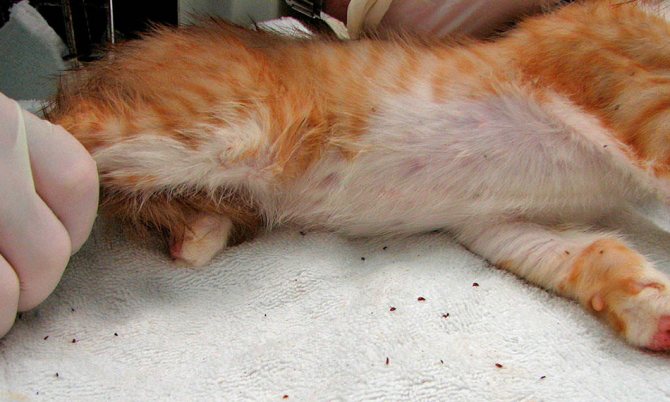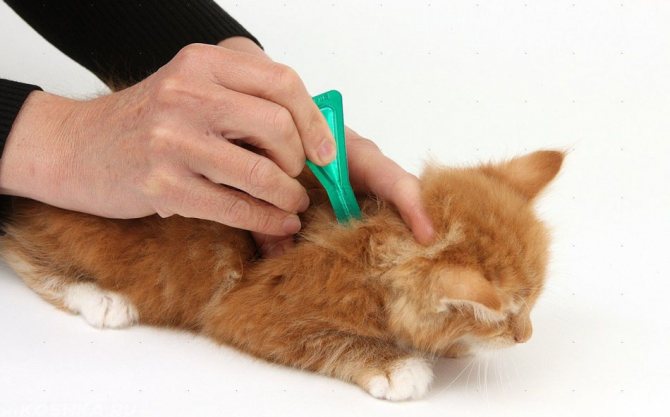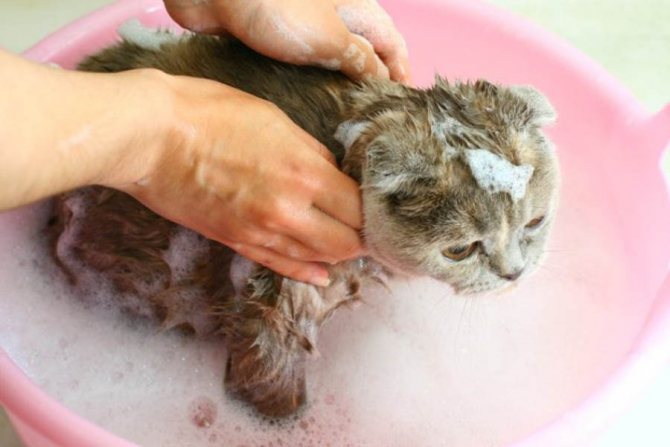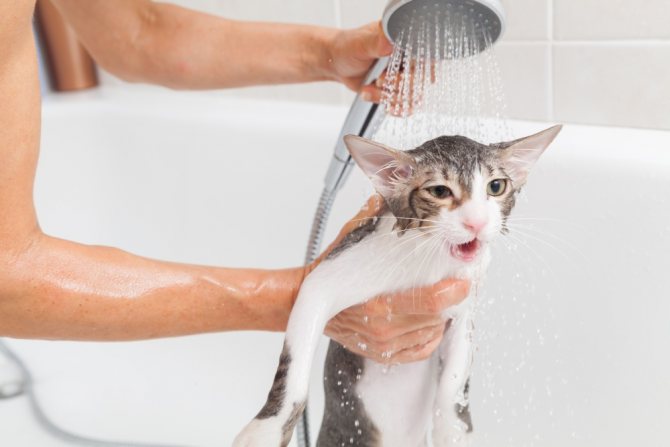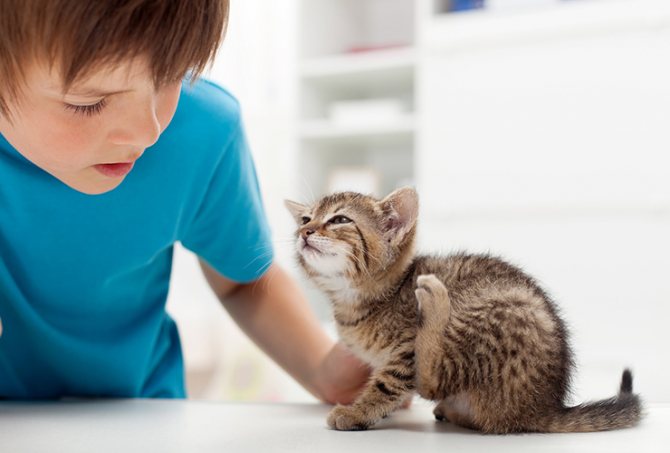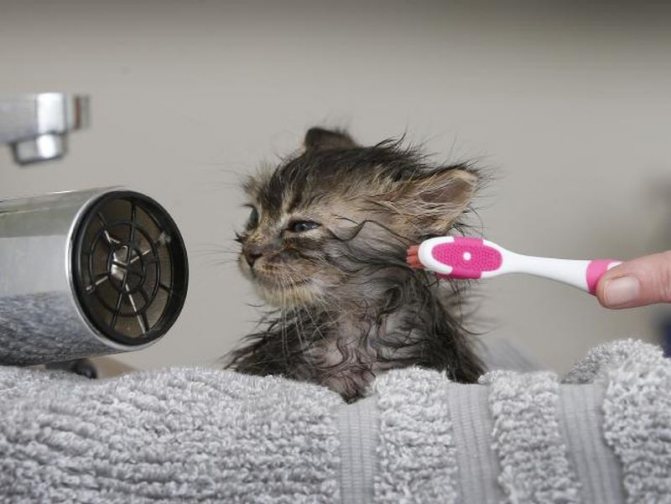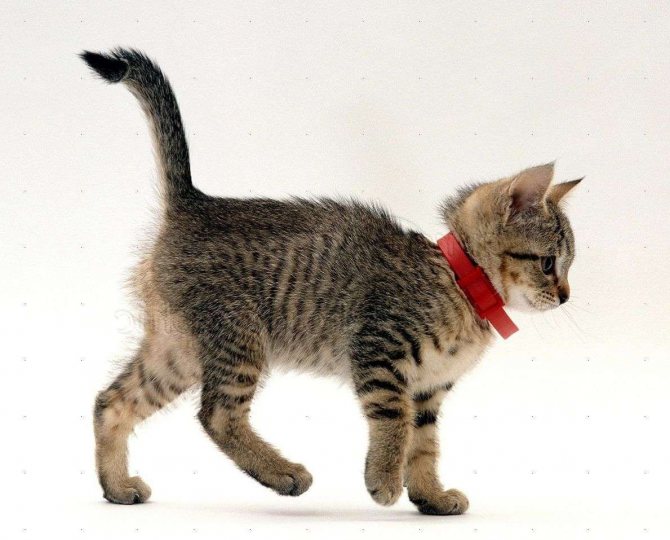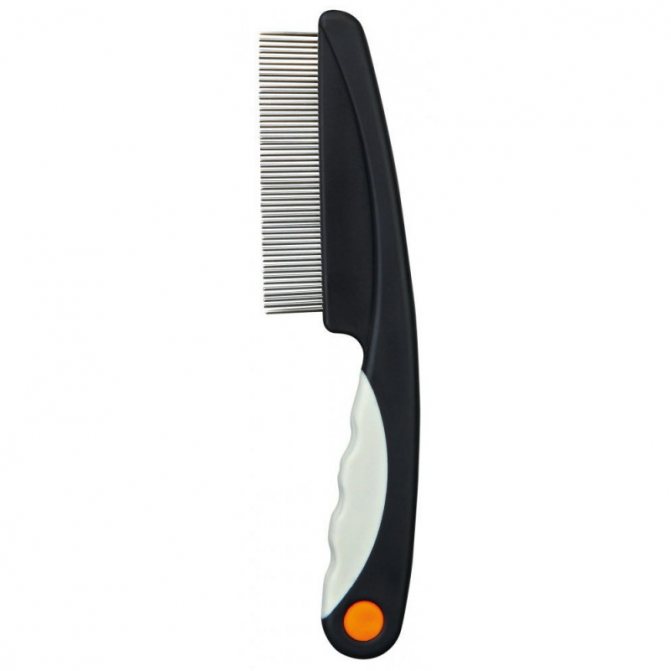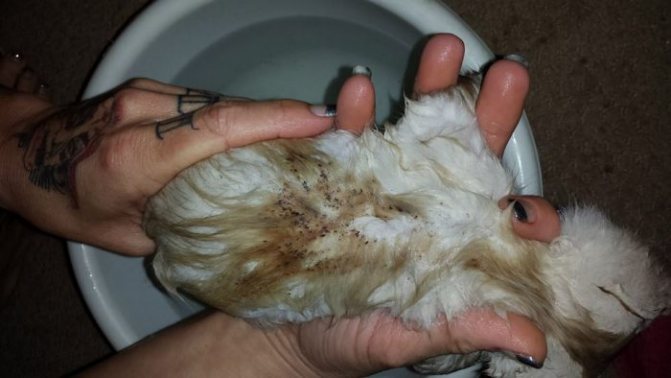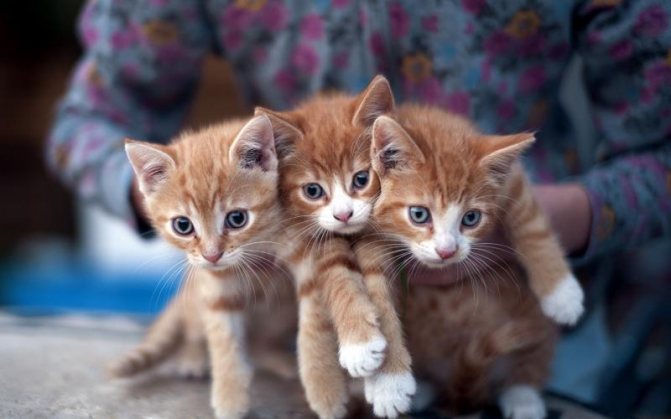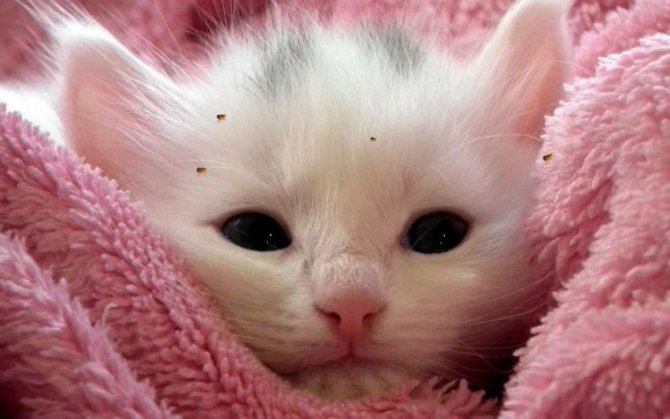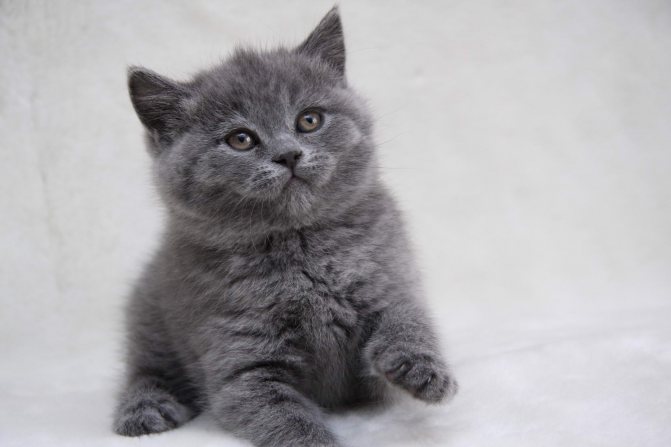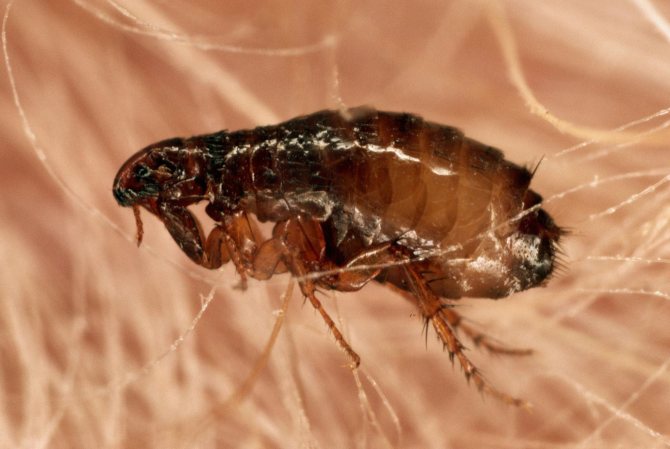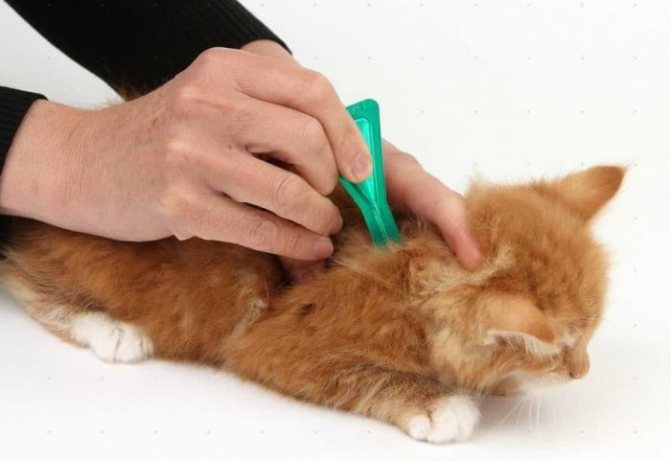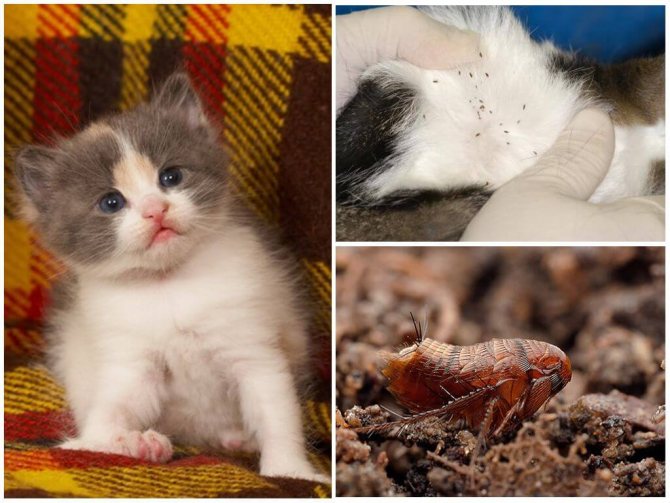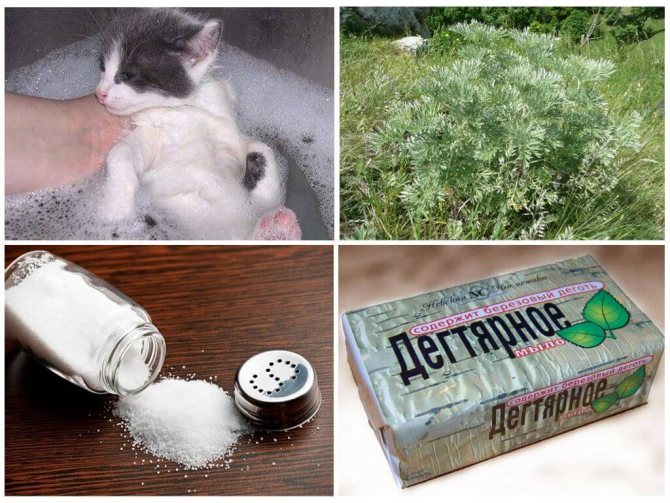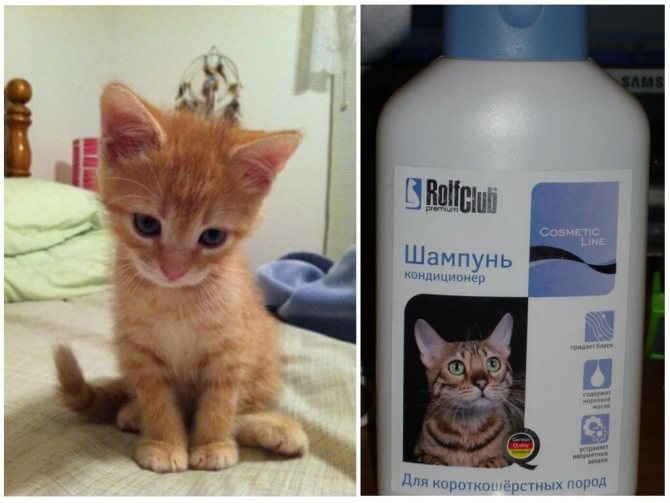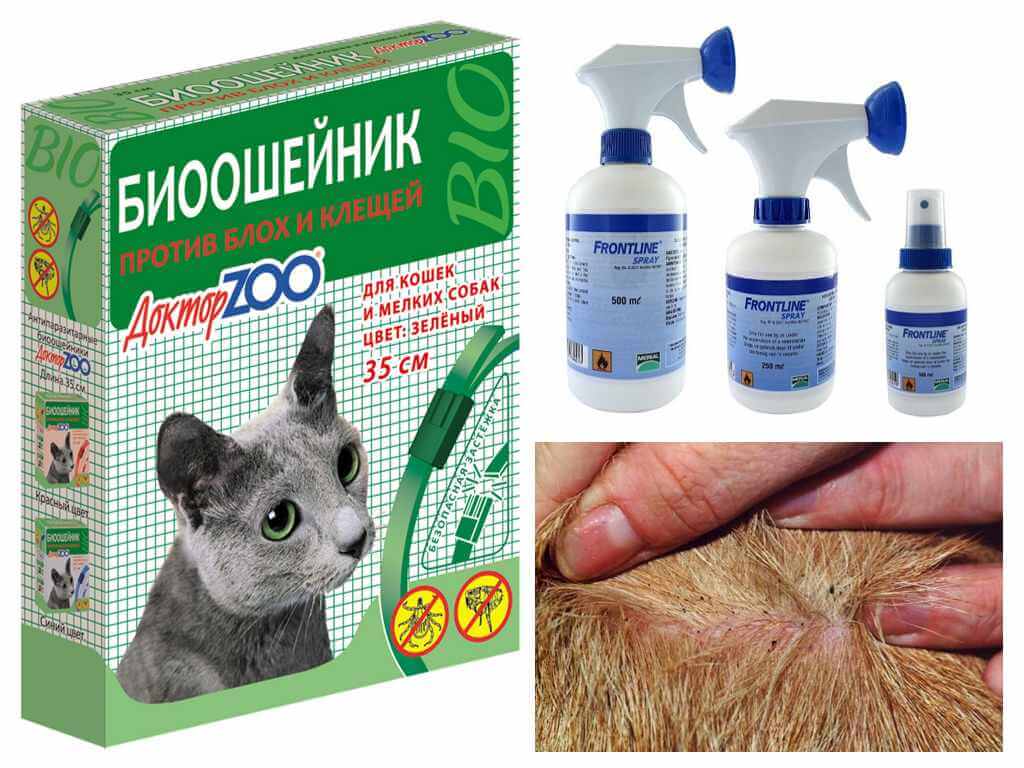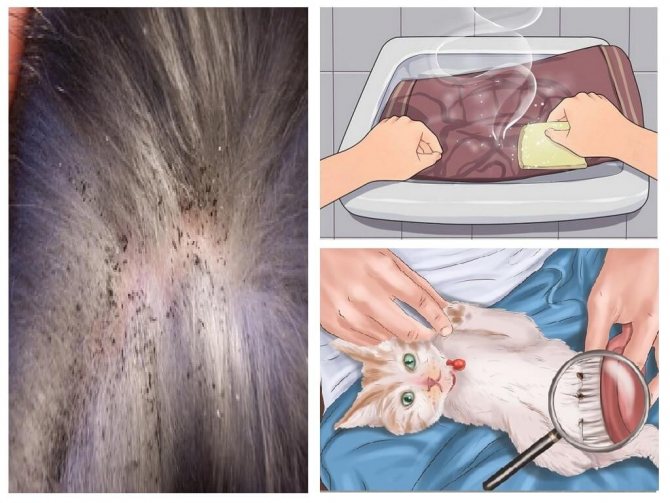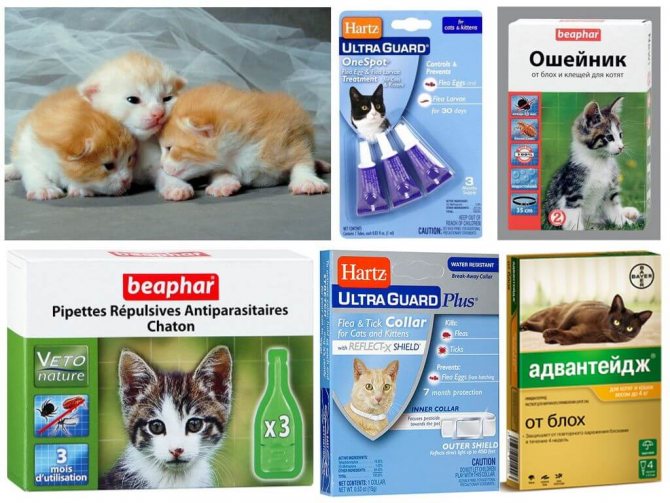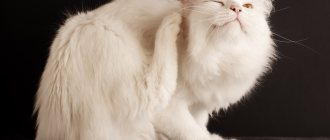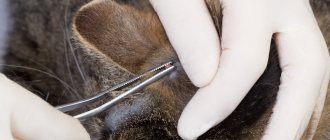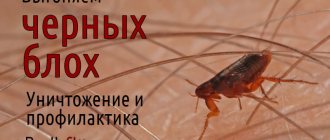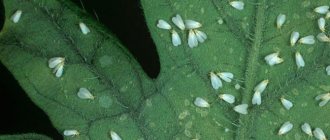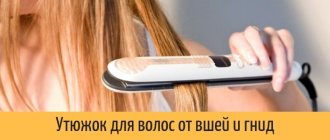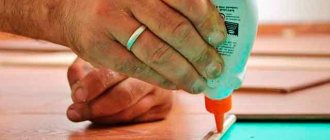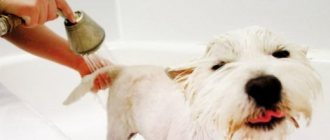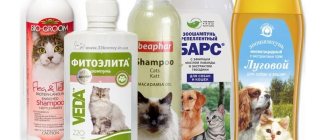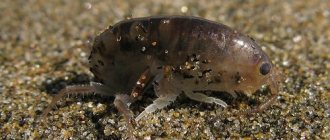How to process: the use of drugs depending on the age of the animal
Before processing the animal's fur and understanding how to rid it of parasites, you need to familiarize yourself with the main nuances of the question.
Flea control products should be selected based on the age of the kitten.
At this age, the kitten still has a rather weak immunity, and most of the means for combating fleas are very aggressive for him. Therefore, it is better to postpone the active struggle with them for a couple of months. If the animal scratches itself all the time and tears the skin with nails,
- The old bedding should be washed and replaced with a new one.
- The place where the baby lives, rinse and vacuum.
- Comb out insects with a fine-toothed comb.
These manipulations should be repeated daily. They will improve the condition of the animal and help delay the use of antiparasitic drugs.
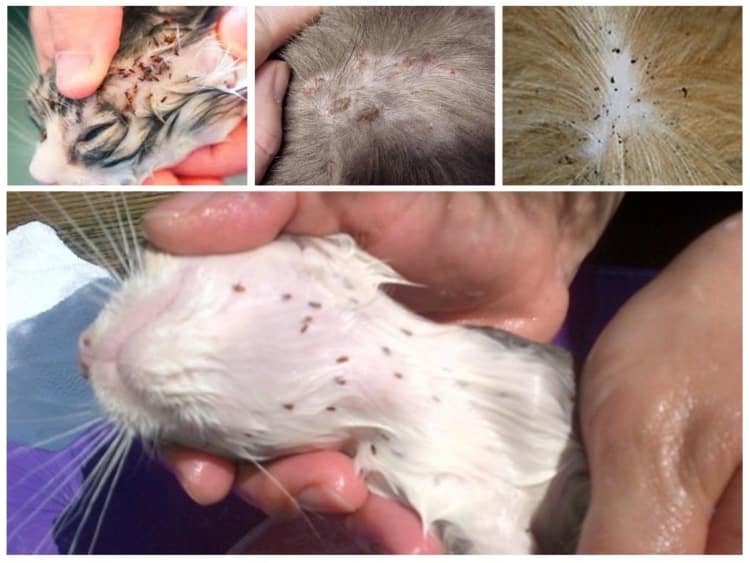
If fleas cause a lot of inconvenience to the kitten, you can use a special shampoo.
Attention! The product should be intended specifically for animals, and not for people, since their acid-base balance is different.
Shampoos are used in the process of bathing a kitten in compliance with all the rules of this process.
The kitten is already old enough, and various methods can be used to eliminate parasites from it: drops on the withers, sprays, a flea collar, as well as folk methods.
- Flea drops. They are among the most convenient in the fight against parasites. It is necessary to part the kitten's fur at the withers and apply the required number of drops. The active ingredients take effect immediately. Caution with drops is needed if the baby has not yet been weaned from the cat. When licking, toxic components can penetrate into the mother's body, as well as into milk.
- Flea sprays. They are also best used if the kitten has already been separated from its mother. The bottle must be shaken before use, placed vertically and sprayed all over the pet's body. After a certain time, the fleas will disappear. It is important to ventilate the room and not let the baby lick the drug until it is completely dry.
- Flea collars. They can be used if the kitten does not have an allergic reaction to the components contained in them. Collars are more commonly used to prevent fleas. It is enough to take out the product and put it on the animal's neck.
Fleas are external parasites of pets. Flea bites are very itchy and can cause allergies and dermatitis in the animal. If the pet is left untreated, its fur may fall out. The body becomes vulnerable to worms and various infections. Flea infestation leads to the development of anemia, which often ends in death.
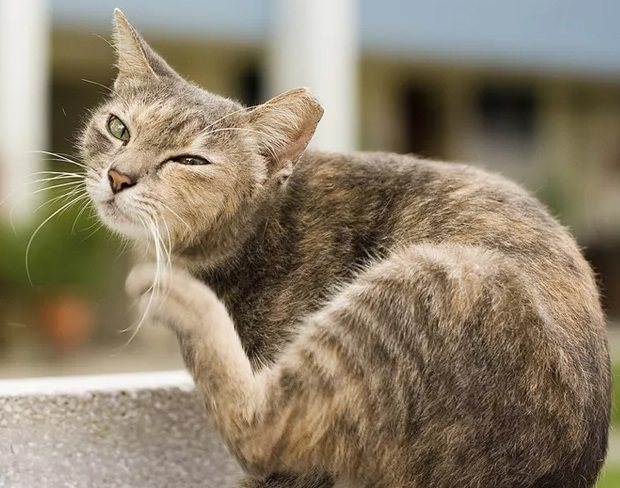

The cat itches
A kitten can become infected immediately after birth. This happens if his mother has not been treated before pregnancy. You can handle babies from the age of 3 months.
Before reaching this age, fleas are removed by hand, the kittens are bathed with a mild shampoo, making sure that it does not get into the eyes, mouth and nose of the baby. After bathing, dry the coat with a hairdryer. During 8-10 hours, the kitten should not be allowed into a cold room with drafts. By licking newborns, the cat removes some of the fleas. It is advisable to wash the bed on which the cat family sleeps every day. You can comb out babies with a small soft comb.
Drops are intended for kittens at least six months old. In pet stores and veterinary pharmacies, you can find special gentle drops for the little ones, but they should also not be used before the babies are 12 weeks old.
Important! For babies, such products as spray, special collar, powder, aerosol are not suitable. Moreover, if you put on a collar for a kitten ahead of time, this can lead to a lag in the growth and development of the pet.
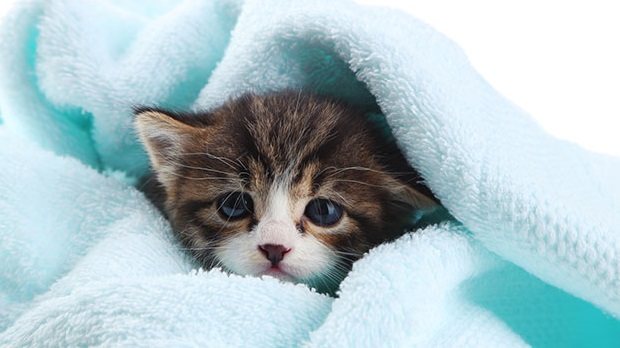

Kitten after bathing
What do fleas look like and why are they dangerous?
Fleas are insects that parasitize animals. They look repulsive: small (up to 2-3 mm), with flattened bodies, chitinous cover with a brownish tint. It's not easy to see them, it's even more difficult to catch them. When trying to touch them, these ectoparasites (living on the surface of the body of a person or animal) show amazing jumping ability.
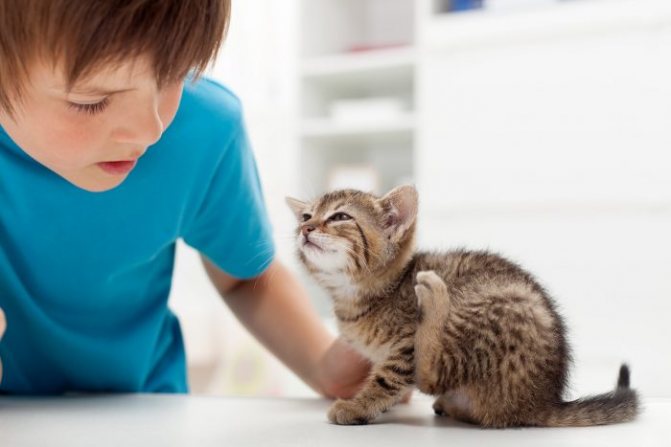

Fleas bring a lot of inconvenience to the pet, and the owner can infect unpleasant diseases
By themselves, fleas are a lot of trouble. The main problem is itching and irritation of the skin at the site of the bite. But the danger of fleas is that they are carriers of dangerous infections (anthrax, encephalitis, hepatitis, plague, etc.), as well as helminths. In a kitten, the appearance of fleas leads to infection with worms.
Signs of the presence of a parasite
Fleas in the fur of a cat
It is not difficult to suspect a pet being infected with fleas by paying attention to its behavior. Insects, biting their owner, cause anxiety in the animal. The cat often itches, tries to catch an uninvited guest with his teeth in his fur coat. If there are too many insects, they annoy the pet a lot. The animal becomes nervous, often runs around the apartment, meows. Excessive nervousness leads to decreased appetite. Restless behavior prompts the owner to think about infection with blood-sucking parasites.
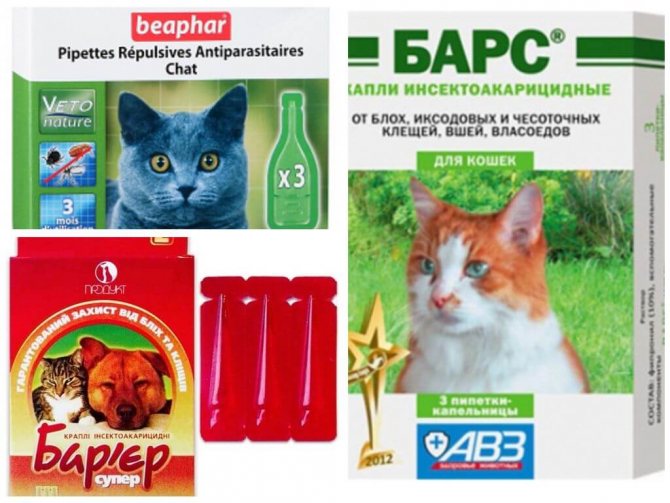

Before dealing with fleas in cats, you should make sure they are there. This can be done by examining the animal at home on your own. To do this, you need to stock up on a rare comb or comb. Parting and combing the coat, you should carefully consider the skin of the pet. You can blow through the fur to improve visibility. The presence of fleas is evidenced by the black dots found on the skin in the form of pieces of dirt (excrement) and the adult specimens of insects themselves.
If it was not possible to find uninvited guests during the examination of the pet, and the behavior of the animal indicates their presence, you should proceed as follows:
- Take a sheet of white paper;
- Carefully comb the coat with a slicker or a comb with frequent teeth;
- Place the contents of the comb onto a piece of paper.
Flea excrement will be clearly visible on a white background.
After making sure that your pet has blood-sucking insects, you should rid the cat of fleas. Parasites bring the animal not only discomfort, but cause a number of skin pathologies, are carriers of dangerous infections, worms. In humans, accidental flea bites can cause allergic reactions. Therefore, you should not hesitate with processing a pet against uninvited guests. Moreover, veterinary pharmacies and pet stores provide a large selection of insecticidal preparations.
First of all, they can get on it from the mother cat. In addition, there are such paths:
- on a walk;
- with shoes or clothes of the owner;
- from other infected animals.
Even the smallest kitten can become infected with fleas. It is important to examine the pet in a timely manner and, if parasites are detected, begin to destroy them as early as possible.
Important! If the animal itches, while the fleas are not visible, be sure to show it to a specialist. Itching can be due to other conditions.
To eliminate fleas, a large number of products are produced today. But you need to know that it is not so easy to remove fleas from kittens.It is important not to buy the first drug that comes along and to adhere to all safety measures.
When choosing a drug, take into account the age of the kitten and the individual characteristics of its body. It will not be superfluous to consult a veterinarian. A note that the drug is suitable for kittens should be on its packaging. Flea products come in a variety of forms.
For small kittens under 2 months old, you can use only shampoos:
- "Doctor ZOO" is a product based on herbal ingredients.
- "Gamma for kittens".
- "Celandine for puppies and kittens."
With a more severe insect infestation and the kitten's age from two months, in addition to shampoos, the following can be used:
- drops;
- aerosols;
- insecticidal solutions;
- anti-flea collars.
We suggest that you familiarize yourself with: How to remove fleas from a cat or a cat at home, how to get rid of parasites from a kitten, where do they come from an animal, photo
Aerosols must be sprayed from a can so that the animal's hair is evenly moistened. For kittens, the following means of this group can be used:
- Bars Forte - for kittens from 10 weeks old.
- "Bolfo" - from 6 weeks.
- BlokhNet - for animals from 12 weeks.
There are liquid parasite control products. Usually these are emulsions and insecticides in ampoules, which are diluted with water and evenly distributed over the animal's coat, then you need to let them dry.
Aminat emulsion is suitable for kittens. It can be used to remove fleas from animals 2 months and older.
The rest of the liquid preparations, such as Butox, Neostomazan and others, are not suitable for animals under six months of age.
Flea drops are insecticides in plastic pipettes. The pipette must be opened and its contents squeezed along the spine onto the skin, where the cat cannot reach during the washing process.
Popular drugs have age restrictions:
- "Bars" is intended for animals from 10 weeks.
- "Dana" - also from 10 weeks.
- Front Line - from 8 weeks.
- "Greenfort Bio-drops" - for kittens from 4 weeks old.
- "Celandine for puppies and kittens" - for animals over 10 weeks old.
- "Stronghold for kittens and puppies" - over 8 weeks old.
Collars do not kill insects, but they prevent re-infestation. Most of them are intended for cats from 6 months old, but
- "Rolf Club" - from 2 months.
- BioVax - from 8 weeks.
- "Delix" - from 8 weeks.
- Celandine Junior and Celandine Maximum - from 8 weeks.
- Beaphar S.O.S. - from 6 weeks.
There are a number of folk remedies. They can be added to the main therapy. Here is one of the popular folk recipes:
- Stir a tablespoon of salt in a glass of water.
- Bathe the kitten in saline for 10 minutes.
- Wipe and dry the animal while combing out harmful insects.
Many are surprised at the reason for the parasite infestation of their pet. Why did fleas appear, if the cat does not leave the apartment, and where did they come from? Bloodsuckers can get caught in the fur of cats in a variety of ways.
- Contact with infected animals;
- A person himself can become a carrier of fleas through shoes or clothes, having been in an infected room;
- Parasites can enter the house from unclean neighbors or from the basement if the apartment is on the ground floor;
- From the grass while walking.
Fleas in cats
The presence of fleas in a cat's fur can be determined by the following signs.
- The cat itches intensely.
- Parasites and traces of their vital activity in the form of small black dots, resembling ground pepper, can be detected by visual inspection of the pet's fur.
- White flea eggs can be seen in the sleeping area of the cat.
- The presence of an allergic reaction on the pet's body, which is a consequence of a flea bite. This is due to the fact that there are poisonous substances in the insect's saliva.
What the parasites look like, their eggs and traces of vital activity, can be seen in the photo.
If these symptoms are found in an animal, it is necessary to apply a flea agent. If the destruction of parasites is not done in time, it will be more difficult to remove fleas from a cat, since bloodsuckers multiply very quickly.
Sources of appearance and signs of flea infestation
A small kitten suffers from fleas more than an adult animal, so it is important to notice in time when the pet has become infected with them.
Where do fleas come from?
There are several options for the appearance of fleas in a newborn kitten. A baby can become infected from a mother cat or other animal living in the house. If the kitten is the only living creature in the apartment, then there is a possibility that he caught the fleas from the previous owner.
Another very common way is the introduction of larvae or even an adult insect on shoes or clothes. A person, without noticing it, can bring a new tenant into the apartment. After entering favorable conditions, individuals feed on the blood of new owners, mate and reproduce. After 21 days, the laid larvae turn into adults, and their life cycle repeats.
Flea infestation symptoms
It is possible to determine that a kitten has fleas only with a thorough examination. Signs to watch out for:
- combed wounds appear on the skin;
- on the belly, ears, muzzle, the insects themselves or their black excrement and white eggs, attached to the wool with a sticky secret, are visible.
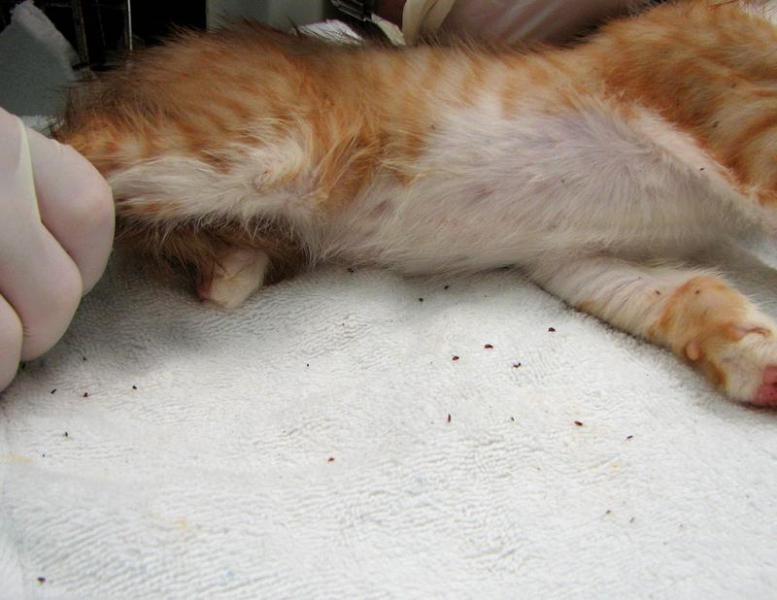

A thorough examination by a veterinarian helps to identify fleas in a kitten
The behavior of a small pet also changes:
- the kitten's sleep becomes restless, he jerks his paws or even jumps;
- the animal does not eat well;
- the baby constantly scratches with his paws or bites with his teeth on individual parts of the body.
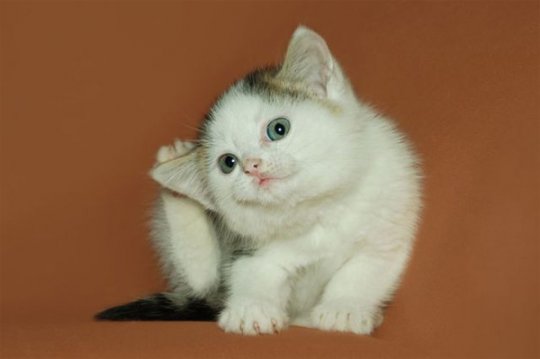

If the kitten is constantly itching, then this may be one of the signs of a flea infection.
How often to treat a kitten from fleas
Kittens over 2 months old need to be treated 2 times a year. But many owners carry out this procedure every 3 months. The medicine destroys fleas and other parasites.
First you need to test it on a small area of the kitten's skin. A small drop should be applied to the paw and see if an allergy occurs. If everything is in order, then you can safely handle the baby.
Note! It is forbidden to treat a nursing cat from worms, as this can harm her children.
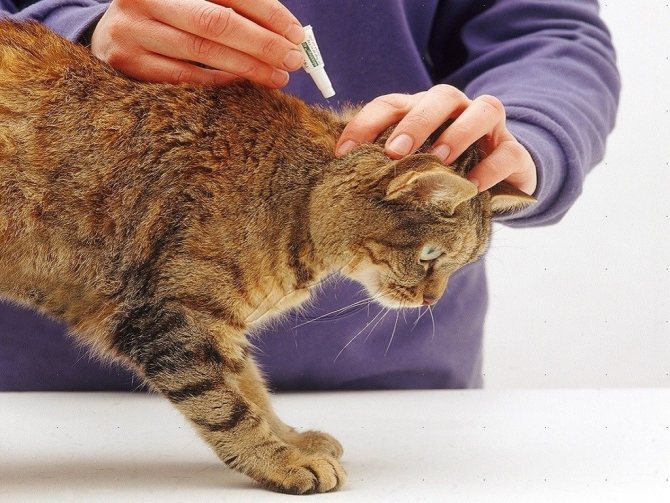

Flea treatment
The dose of medication depends on the age and weight of the pet. Ideally, it should be prescribed by a veterinarian: too little will not get rid of parasites, and too much can lead to poisoning.
Flea remedy should be applied to the withers of the animal. This is the most convenient place for applying drops and ointments, because the cat will not be able to lick the drug from there.
There are drops that need to be dripped onto three different places along the length of the spine, but such products are unsafe and are only suitable for very severe infections.
It is advisable to know in advance how to drip drops on the withers of the cat. In this case, it is necessary to slightly spread the coat with your fingers and drip 1-2 drops. You can then lightly massage the skin to help absorb the medicine. It is not necessary to rub in the drops too intensively.
The skin on the withers should be dry, intact and healthy. Do not apply the drug to damaged skin. If there is a wound or inflammation on the withers of the pet, you must use other means (spray or powder) or wait for the skin to heal.
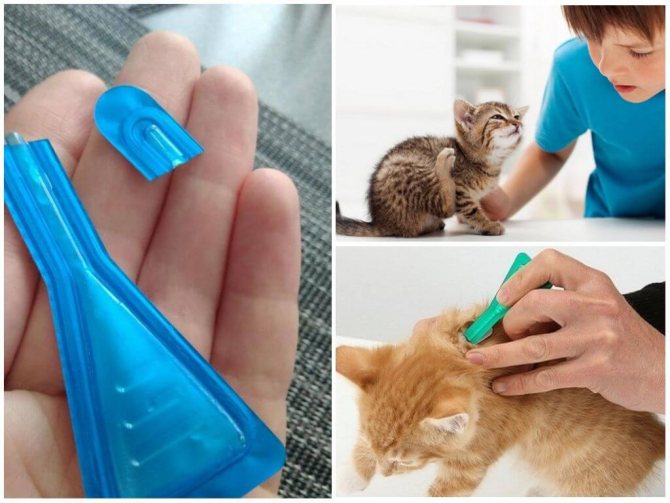

How to treat a cat for fleas
Success in combating fleas depends on the appropriate dose of the medication and on adherence to safety measures. Cleanliness in the home of a kitten plays a critical role in maintaining its health. With flea remedies, it is necessary to treat not only the pet itself, but also the entire room. When the parasites disappear from the home, there will be no sources of infection, which means that the cat will be reliably protected from parasites.
The area can be sprayed with anti-flea spray.But a more noticeable effect will be brought by washing floors with a flea cleaner. A small amount of the drug should be diluted in a bucket of water and the floors should be washed with this liquid.
Attention! After cleaning the floors in the apartment, you need to be careful that the cats do not pick up anything from the floor and do not lick it.
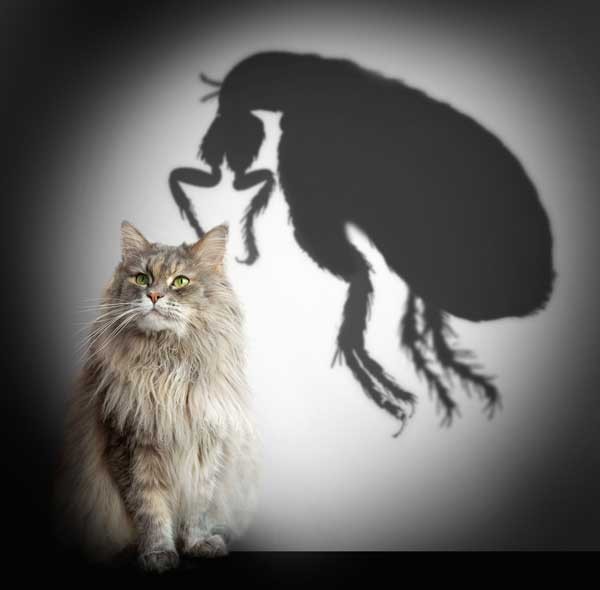

Danger of fleas
A kitten should not be bathed 3 days before treatment for fleas, as well as 3-5 days after it. Much depends on the chemical composition of the drug: water-based drops are absorbed into the skin in 1-2 days, while oil-based preparations take 3-5 days.
Flea medication can be toxic to pets. If used improperly, these products cause allergies and poisoning. Allergy is most often manifested by redness, swelling, itching of the skin at the site of application of the drops. But the nervous system of the cat may suffer, then it may experience convulsions and salivation.
These symptoms appear in the first few hours after exposure to the drug. At risk are cats with neurological disorders such as cerebellar ataxia or spinal trauma.
To keep your furry pet safe, you need to carefully choose the dose of the drug and monitor for possible side effects. It is advisable that all recommendations are prescribed by a veterinarian.
Important! If you experience any negative symptoms, changes in the behavior of the animal, you should immediately contact the veterinary clinic.
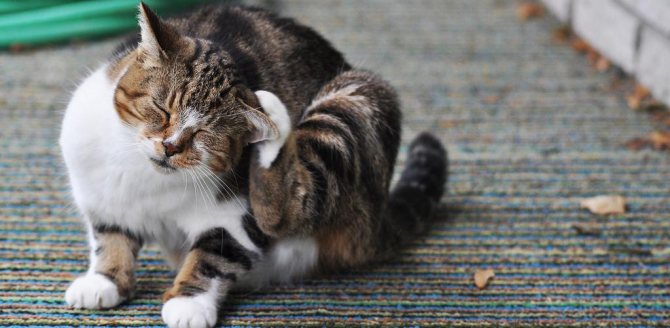

The cat is combing
After treating a fluffy pet from fleas, force majeure situations sometimes arise. If the cat had a lot of fleas, then in the first hours after applying the drops, these parasites become more aggressive. Because of this, the cat itches a lot. It goes away in a day.
The same happens if the animal suffers from flea dermatitis. In this case, severe itching is caused not so much by the action of the drops as by the allergy to flea bites.
Especially dangerous is the condition when the cat suddenly has an individual drug intolerance. An experienced veterinarian should treat a cat allergy to the medication.
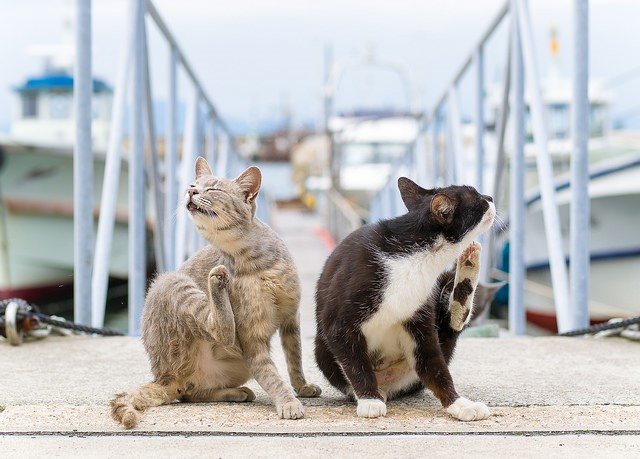

Cats have fleas
Most drugs protect cats not only from fleas, but also from lice, itch and ixodid ticks. You can choose any broad-spectrum drug.
The most famous remedies:
- Leopard - protects against fleas and ticks, treats otodectosis, sarcoptic mange, notoedrosis, cheiletiellosis, suitable for frequent use.
- Stronghold is a complex drug that destroys external and internal parasites (fleas, ticks, dirofilaria, ascrid, toxocar, hookworm). Suitable only for a strong and healthy body, but not for small and weak animals.
- Frontline is a convenient tool (dose for 1 cat in 1 package). Acts gently, provides long-lasting and reliable protection.
- Celandine - fast acting, inexpensive, easy to use. This is a rather toxic drug, so it should be used with great care only on the recommendation of a veterinarian. Many cats are allergic to it.
- Green Fort - oil drops that kill parasites. Relatively safe and easy to use.
We suggest that you familiarize yourself with: How to remove lice from cats
Older kittens and adult cats can be sprayed. One of the safest is Bolfo spray.
Additional Information! For prevention, you can use some natural remedies. You can independently prepare a decoction of fresh needles and process the kitten's wool with it. In no case should you water the animal with this broth or add it to food.
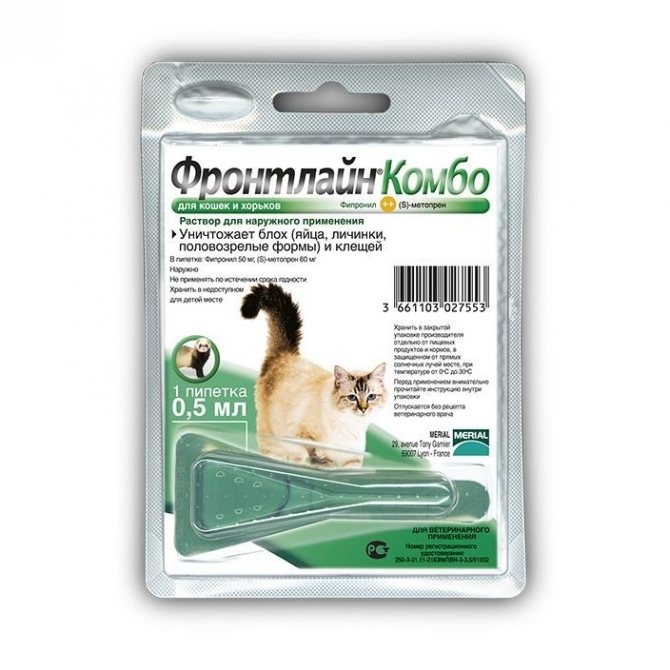

Frontline
Flea drops are a simple and useful remedy that will reliably protect the cat from such troubles as blood-sucking insects. It is easy to use them - even one person can handle it. In this case, side reactions and complications do not occur so often.
To combat cat fleas and other external parasites, the pharmaceutical industry produces a wide variety of insecticidal forms: drops, shampoos, sprays, collars, pills and even injections.
Flea shampoos
Most often, owners purchase flea shampoos for home treatment of their pets. They are easy to use and not highly toxic. Shampoos can be used on small kittens, unlike other anti-flea drugs. If your pet has thick and long hair, shampoo is one of the most effective ways to quickly get rid of fleas from a cat.
They include special substances - insecticides, which have a detrimental effect on both adults and insect larvae, for example, permethrin, phenotrin, etofenprox. In addition, manufacturers add herbal extracts to shampoos, which have an anti-inflammatory effect and eliminate itching from bites. Almost all detergents are hypoallergenic for cats.
With strict adherence to the instructions, shampoos allow you to destroy blood-sucking insects and not harm your pet. However, it is often not recommended to use detergents against fleas, as toxic substances accumulate in the cat's body.
Flea shampoos for cats
Drops on the withers
Drops are an effective remedy against blood-sucking insects in cats. The active ingredients of this form of insecticides, as a rule, are: ivermectin, permethrin, fipronil, pyriproxyfen and others. The substances quickly have a detrimental effect on feline fleas.
For processing, the drug is most often applied to the withers of the animal to prevent the insecticide from licking. The successful use of drops is based on the prolonged action of the agent: the active substance accumulates in the skin of the animal and protects the pet from uninvited guests for a long time.
Drops are safe to use if you follow certain rules and instructions for a particular drug. There are certain rules on how to anoint a cat from fleas with drops:
- before applying drops, the animal should be weighed and the indicated dosage should be followed exactly;
- the pet's coat must be carefully combed;
- drops should be applied to dry skin, having previously parted the coat;
- after applying this form of insecticide, the animal should be protected from contact with small children and from water procedures for 48 hours.
When using drops on the withers, you should be aware that not all of them are suitable for pregnant and lactating cats, small kittens, sick and weakened animals. The drops can also cause an allergic reaction.
The owner of a pet that has access to the street needs to choose how to remove fleas from the cat and prevent re-infection. Flea collars are especially popular in such situations, many of which also protect the animal from ticks. Collars are impregnated with the same insecticides found in drops, sprays, and other anti-flea products. They penetrate the skin and have a detrimental effect on parasites.
Collars protect pets from attacks of blood-sucking insects for a long time, are easy to use. The duration of the anti-flea effect ranges from 2 to 6 months. However, you should be aware that the collar does not work against flea larvae and eggs, and, like other insecticides, can cause allergies in the cat.
Flea allergic dermatitis
Often, as a result of an attack by feline fleas, a pet develops skin diseases:
- Flea allergic dermatitis. Often, domestic cats are hypersensitive to toxic substances in the saliva of a flea. This causes a severe allergic reaction in the animal. The site of insect bites is combed by the cat until it bleeds, crusts are formed.Damaged skin becomes infected with pathogenic organisms, inflammatory processes develop. It is important to cure the cat from fleas in time. Flea dermatitis is accompanied by thinning and hair loss, and the formation of eosinophilic granulomas. The progression of the disease leads to the nervousness of the animal, a decrease in body weight, and a loss of aesthetic appearance.
- Anemia in kittens. The defeat of babies by blood-sucking insects poses a serious danger to them due to the development of anemia. With a massive infestation of newborns with fleas, deaths from exhaustion and anemia are not uncommon. Therefore, it is important for the owner to rid the cat of fleas long before giving birth.
Means for removing fleas from domestic cats
When parasites appear, pet owners are interested in how and how to remove fleas from a cat. When choosing an effective means for removing fleas, you should pay attention to the composition of the drug. It is also necessary to take into account the age of the cat or cat, the breed of the animal, the degree of infection with parasites and the possible presence of other pets.
The safest method for kittens or cats "on drift" is the method of combing out bloodsuckers using a fine comb. Complete elimination of bloodsuckers can be achieved by daily combing the animal's fur. The comb should be washed periodically with water and wiped with a light-colored cloth. Combed out fleas, their larvae, eggs and excrement are burned or destroyed by hand.
Today there are a lot of tools that will help rid a cat of fleas.
Shampoo
Flea shampoos for cats and dogs
One of the means by which you can remove fleas from a cat is shampoo. Its use gives a good effect, however, not every pet is to their liking. The method of using flea shampoo is quite simple. The detergent must be well lather on the cat's fur and leave for a couple of minutes, then rinse thoroughly with clean water.
When buying a shampoo, you should pay attention to the composition of the preparation: it should not contain components harmful to the health of the animal. Shampoos Bars, Lugovoy, Insectin and Phytoelita are especially popular today.
Injections and pills
If you find fleas in a domestic cat, you can help get rid of them with injections. Their advantage is the safety of the pet in case of possible contact with their relatives. Flea injections are contraindicated for lactating and pregnant cats due to the fact that the active ingredient of the drug can harm the health of kittens. You can get a flea injection in almost any veterinarian's office.
Pills have a similar effect. The advantage of this method lies in its action from the inside, which limits the ability of the cat to lick the drug from the surface of its fur. The active substance contained in the tablets, getting into the blood of the animal, has a destructive effect on insects that bite it. The maximum effect can be achieved by combining this method with other methods of struggle.
Flea drops for cats
Collars
Sprays give a good effect in the fight against parasites. The drug is sprayed on the cat's fur, causing the death of insects. It is important to use the product in accordance with its instructions. The main condition is to prevent the substance from getting into the eyes and mucous membranes of the pet. Poisoning fleas in this way is preferable in the fresh air or in a well-ventilated area. More often, cat lovers prefer such sprays as Frontline, Delix or Bars.
We suggest that you familiarize yourself with: Fufanon for bedbugs - instructions for use
Flea sprays in cats
Folk remedies
How to get rid of fleas from a cat using folk methods is very simple.
- The smell of wormwood, rosemary, lavender, geranium, eucalyptus, tansy will scare off parasites. A decoction prepared from these herbs should be used to treat the animal's hair and cat's mattress.In case of severe flea infestation, the procedure must be repeated after 3 days. For preventive purposes, you need to process the cat's hair 2 times a month.
- If there is a flea cat in the house, then you can poison insects with the help of essential oils - cedar or rosemary. It is enough to add a few drops to the shampoo and wash your pet's hair well with it.
- You can also get rid of fleas with garlic. Its smell causes parasites to panic. To process pet hair, you need to take 2-3 cloves of garlic and grate or chop with a knife. Pour 1 liter of warm boiled water and leave for 10-12 hours. This infusion needs to process the withers of the cat. The effect will be enhanced if brewer's yeast is added to the infusion at the tip of a knife. In no case should the product be applied to other parts of the body, since garlic has toxic properties and is contraindicated in animals.
- You can also poison fleas from a cat using saline and needles, which must be filled with the pet's litter.
Folk remedies for fleas in cats
Folk remedies
In folk practice, a whole arsenal of tools has accumulated for the destruction of fleas in kittens. Unlike medications, they are based on herbs that do not harm the health of the cat and kitten. These include, for example:
- Sagebrush. A tablespoon of dry leaves is poured with boiling water (500 ml) and boiled for 15 minutes. The resulting broth is used to wash the animal. A mother cat, even licking her offspring, will not receive poisoning. Fresh wormwood grass can simply be put in the kitten's house.
- Tansy. Similarly to wormwood, a decoction of tansy is made. It is used to treat a kitten's fur.
- Garlic. The head of garlic is passed through a press, poured with a liter of warm water and insisted for 12 hours. The resulting infusion is used to treat the kitten's skin, especially in the places of the greatest accumulation of insects: in the armpits, on the tummy, in the groin.
- Geranium. 2 tablespoons of leaves are poured with 500 ml of water and boiled for 20 minutes. Little kittens are bathed in the broth.
- Lemon. A small lemon is crushed, poured into a glass of water and insisted for a day. Then the kitten is sprayed with a ready-made infusion from a spray bottle.
- Essential oils. Mint, cedar, lemon, geranium, rosemary and lavender oils have proven to be effective against fleas. 2-3 drops of oil are diluted in 2-3 glasses of water and sprayed on the kittens.
You can drive out fleas in another proven way: fill the kitten's bed with pine sawdust or fresh shavings.
Video: personal experience of using folk remedies against fleas
When can you wash your kitten after applying drops
A caring owner should always remember how to properly drip flea drops to a cat. Before use, you must carefully read the instructions for the drug and show the cat to the veterinarian in order to avoid pet allergies and other complications.
Drops on the withers are used only for those kittens who already eat on their own. For babies who feed on mother's milk, these funds are contraindicated. Do not treat kittens with products for adult cats.
Attention! If flea drops get into the animal's eyes, nose and mouth, rinse them immediately with water.
Care should be taken to ensure that cats do not lick each other for 2-3 days after flea treatment. For safety, you can put on a medical collar for kittens.
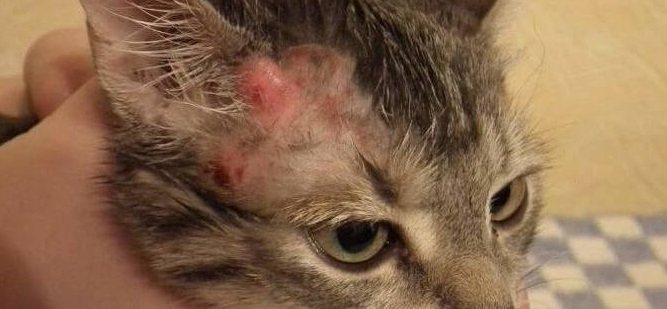

Flea bite allergy
Bathing kittens
Not everyone knows how to wash a kitten for the first time. But how often you can wash a kitten with flea shampoo is known to few. You must strictly adhere to the instructions on the package. The manufacturer also indicates on it after how many days the procedure can be repeated.
You can wash the baby 2 weeks after its birth. There should be no drafts in the room, therefore windows and doors should be closed. Prepare a bowl of water of about 38 ° C and a special shampoo suitable for this age. Claws should be trimmed before bathing.After that, the wool should be well moistened and the baby's body should be lathered with a small amount of shampoo. During the procedure, it is necessary to ensure that water does not get into the ears and eyes of the kitten. After that, the wool is thoroughly washed with a stream of water. For drying, instead of a hair dryer, it is better to use a terry towel.
Poisoning may occur during the use of drugs. If the kitten does not eat, he has increased salivation, apathy, drowsiness - these are the first signs that speak of poisoning. You should immediately consult a doctor who will prescribe treatment and prescribe pills or other medications.
What to do if a cat has fleas
Removing fleas from cats at home is a simple process, however, it requires patience.
- First, you should remove the parasitic insects from the fur of a cat or cat using one of the available means. After several days, it is necessary to comb out the pet's hair from dead fleas and their larvae.
- Buying a collar will help prevent cat fleas. For this purpose, tablets can also be used. Brush out and inspect regularly
- You also need to pay attention to the place where the animal sleeps. Treat its mattress or bedding with any anti-flea agent, after which it is better to stuff it with needles.
- In parallel, it is required to process the room with the most effective means where the domestic cat is kept in order to destroy the insects that have spread in it. It is necessary to wash the floor using whiteness, herbal decoctions or a solution of baking soda and salt. Particularly carefully go through the places where the parasites were found.
- A household hairdryer can be used to eliminate breeding grounds. It will help not only dry out dampness in hard-to-reach places, but also flea eggs that will not survive such tests. Beddings and things infected by bloodsuckers need to be washed and ironed.
- If possible, contact with infected animals should be excluded so that the parasites do not have to be poisoned again.
- Regularly examine the cat's fur and do prophylaxis using sprays, pills or collars. You can bathe your pet periodically using flea shampoo or herbal teas. After all, preventing a disease is much easier and more effective than treating it. Therefore, if you deprive fleas of the opportunity to infect a domestic cat or cat, then the treatment of the animal will not be needed later.
Bathing and mechanical wrestling
After processing the mother-cat, you should start cleaning the sleeping place of the feline family. The bedding and the soft stove bench must be washed at a temperature of 60-90 degrees (in winter, when it is cold, you can take the house out into the cold), cat combs should be doused with boiling water. It will not be superfluous to carry out a general cleaning of the entire house.
If all the measures taken did not give the desired result, and it was not possible to completely get rid of fleas, you can start bathing the babies. However, it should be remembered that newborn kittens should be washed with extreme caution, in a warm room, where there are no drafts.
As an insecticide when bathing, use:
- foam of tar or baby soap;
- mild soap solution with flea shampoo for kittens;
- a decoction of Persian chamomile, tansy or wormwood.
The kids are gently dipped in warm water and lightly rubbed the detergent into the fur, avoiding the foam on the face. The procedure should be carried out quickly so that the animals do not catch cold. In case of abundant infection, the detergent composition is left on the kittens for about a minute, then washed off. After bathing, the kittens are wiped or dried with a hair dryer, placed on a heating pad until completely dry, and then returned to the cat.
One of the safest ways to get rid of fleas in newborn kittens is brushing. The fur of small furry cats is not as thick as that of adult cats, so the parasites are visible to the naked eye. For the procedure, you should prepare:
- a bowl of water;
- special comb with fine teeth to combat head lice (sold in the pharmacy).
The baby should be carefully combed out, holding over a bowl of water so that the caught insects fall there. The procedure must be repeated several times. This method is devoid of any contraindications and side effects, therefore it is absolutely safe for newborn kittens.
At what age can babies be treated with veterinary insecticidal drugs? The safest remedy is recommended to be applied no earlier than the kittens are 8 weeks old. Fleas should be poisoned in animals with weak immunity no earlier than they are 6 months old. In this case, the kittens must be weaned from the mother.
Advantages and disadvantages of using drops
Flea drops have many distinct advantages over other forms of anti-flea medication.
Advantages:
- they act quickly (after 20 minutes the cat will feel better, and a few days later the parasites will die);
- effective (reliably protect the cat from fleas for at least 1-2 months);
- relatively safe;
- easy to use.
Unfortunately, this tool is not suitable for everyone. In some cases, it needs to be replaced by other means or processing should be postponed for some time.
Disadvantages:
- can cause allergies;
- not suitable for small kittens, pregnant, lactating cats;
- dangerous for sick, emaciated, weakened animals.

